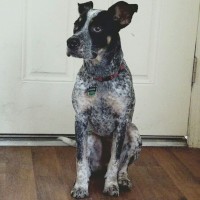Appearance of the Box Heeler
|
| The Box Heeler is a hybrid of the Boxer and the Australian Cattle Dog. Although we have no information on the appearance of the Box Heeler, we can consider the appearance of the hybrid's parent breeds. The Boxer is large in size, while the Australian Cattle Dog is generally a medium-sized dog. The Boxer has a short, smooth, glossy coat, while the Australian Cattle Dog has a weather-resistant double coat that is longer and thicker around the dog's neck. Box Heeler colors can include red, brindle, tan and blue. This hybrid will have dark eyes. A very attractive dog that will turn heads, it may have ears quite different from both parents in that they may fall closer to the head. His body is long and his gait is agile and determined. |
Temperament of the Box Heeler
|
| The Box Heeler will inherit its temperament from its parents. Boxers are playful, curious, attentive and devoted to their families. As dogs of the breed tend to be gentle and patient, the Boxer is a good choice for a family with children. The Boxer can be stubborn, but is also sensitive and will respond well to training. Although the Boxer can be aggressive when meeting strange dogs, it will generally do well with other dogs and pets. The Australian Cattle Dog is independent and stubborn, with lots of energy. Dogs of the breed do well if they have a job to do, as this will help them stay challenged both physically and mentally. With proper training, the Australian Cattle Dog is generally obedient and responsive, and will do well with the children he was with when he was growing up as a puppy. Australian Cattle Dogs have been known to nip at the heels of children who are not members of their family, so caution is advised. Dogs of this breed can be aggressive with other dogs. Just because the Australian Cattle Dog is independent doesn't mean it wants to be alone; it will be a loyal and protective family member with a hint of strangers. Your Box Heeler will have a temperament like its parents in that it has a mind of its own, loves its family but is also prone to independence. |
Needs and activities of the Box Heeler
|
| The Box Heeler's activity requirements can be measured against those of its parents. A Boxer will enjoy a good run, but can meet its exercise needs with a long walk on a leash. Boxers can live happily in an apartment if they get enough exercise, although a medium-sized fenced yard is recommended. Australian Cattle Dogs, on the other hand, need more than a daily walk to meet their activity needs. Physical and mental activity is necessary for the breed, and can include obedience lessons or other challenges. A large, fenced yard is recommended for the Australian Box Heeler. To keep your Box Heeler happy and content, additional activities that exercise mind and body are necessary. This hybrid is not recommended for first-time dog owners. |
Maintenance of the Box Heeler
|
| The maintenance of your Box Heeler will be moderate and will depend on the inherited coat. The coat will be short and dense, requiring weekly brushing with a firm bristle brush to remove loose fur. Because of the shortness of the coat, tangling is not a problem. We recommend bathing your Box Heeler only when absolutely necessary, as this will remove the natural oils from its skin. This hybrid may have climate sensitivity due to the Boxer parent. |









 English (United Kingdom)
English (United Kingdom)